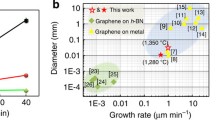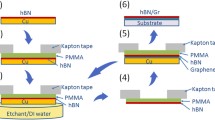Abstract
Hexagonal boron nitride (h-BN) is an outstanding two-dimensional material in terms of thermal stability and chemical inertness, enabling its versatile applications under harsh conditions. However, the oxidation resistance of h-BN is significantly reduced in the presence of metallic catalysts, which could be readily introduced during commonly adapted transfer methods of chemical vapor-deposited samples through the wet etching of metallic substrates. Here we propose a clean dry transfer method for monolayer h- BN film grown on the copper (Cu) surface. Thus, the mechanical delamination of the h-BN film from the substrates becomes feasible as their interfacial adhesion energy is significantly reduced because of the oxygen intercalation and surface oxidation of Cu during exposure to air. The drytransferred h-BN film is proven to be free of metallic (iron) contaminants, in sharp contrast to the wet-transferred h-BN film, which contains significant amounts of metallic residues. The clean transfer of h-BN considerably enhances its oxidation resistance by 50–100°C, yielding nearly the ideal performance of h-BN. As a result, graphene layers coated with drytransferred monolayer h-BN film exhibit enhanced robustness to temperatures in the air up to 700°C, indicating the advantage of the proposed dry transfer method.

摘要
六方氮化硼(h-BN)是一种具有出色热稳定性和化学惰性的二维 材料, 在苛刻条件下应用广泛. 然而, 表面金属催化剂会使其抗氧化性 显著降低. 对于通过化学气相沉积制备的样品, 常规通过湿法蚀刻金属 基底的转移方法不可避免地会引入金属残留. 我们这里提出了一种针 对铜表面生长的单层h-BN薄膜的洁净干转移方法. 空气环境下界面氧 插层和表面铜氧化导致界面粘附能量显著降低, 因而h-BN薄膜可以从 基底上被直接机械剥离开. 与湿法转移制备的薄膜形成鲜明对比, 干法 转移得到的h-BN薄膜几乎没有金属(铁)污染, 使其抗氧化性提高了 50–100°C, 甚至接**其本征性能. 在干法转移的单层h-BN薄膜保护下, 单层石墨烯在空气中的耐受温度提高到700°C, 展示了这一干转移方法 的优势.
Similar content being viewed by others
References
Dean CR, Young AF, Meric I, et al. Boron nitride substrates for highquality graphene electronics. Nat Nanotech, 2010, 5: 722–726
Wang Z, Wang YB, Yin J, et al. Composite super-moiré lattices in double-aligned graphene heterostructures. Sci Adv, 2019, 5: eaay8897
Hod O, Meyer E, Zheng Q, et al. Structural superlubricity and ultralow friction across the length scales. Nature, 2018, 563: 485–492
Yin J, Li J, Hang Y, et al. Boron nitride nanostructures: Fabrication, functionalization and applications. Small, 2016, 12: 2942–2968
Li LH, Cervenka J, Watanabe K, et al. Strong oxidation resistance of atomically thin boron nitride nanosheets. ACS Nano, 2014, 8: 1457–1462
Liu Z, Gong Y, Zhou W, et al. Ultrathin high-temperature oxidationresistant coatings of hexagonal boron nitride. Nat Commun, 2013, 4: 2541
Li LH, **ng T, Chen Y, et al. Boron nitride nanosheets for metal protection. Adv Mater Interfaces, 2014, 1: 1300132
Li X, Long Y, Ma L, et al. Coating performance of hexagonal boron nitride and graphene layers. 2D Mater, 2021, 8: 034002
Son SK, Šiškins M, Mullan C, et al. Graphene hot-electron light bulb: Incandescence from hBN-encapsulated graphene in air. 2D Mater, 2018, 5: 011006
Šiškins M, Mullan C, Son SK, et al. High-temperature electronic devices enabled by hBN-encapsulated graphene. Appl Phys Lett, 2019, 114: 123104
Zhao Y, Wu X, Yang J, et al. Oxidation of a two-dimensional hexagonal boron nitride monolayer: A first-principles study. Phys Chem Chem Phys, 2012, 14: 5545
Dong J, Fu Q, Li H, et al. Reaction-induced strong metal-support interactions between metals and inert boron nitride nanosheets. J Am Chem Soc, 2020, 142: 17167–17174
Song T, Dong J, Li R, et al. Oxidative strong metal-support interactions between metals and inert boron nitride. J Phys Chem Lett, 2021, 12: 4187–4194
Dong J, Gao L, Fu Q. Hexagonal boron nitride meeting metal: A new opportunity and territory in heterogeneous catalysis. J Phys Chem Lett, 2021, 12: 9608–9619
Kidambi PR, Blume R, Kling J, et al. In situ observations during chemical vapor deposition of hexagonal boron nitride on polycrystalline copper. Chem Mater, 2014, 26: 6380–6392
Liao Y, Tu K, Han X, et al. Oxidative etching of hexagonal boron nitride toward nanosheets with defined edges and holes. Sci Rep, 2015, 5: 14510
Wang L, Wu B, Jiang L, et al. Growth and etching of monolayer hexagonal boron nitride. Adv Mater, 2015, 27: 4858–4864
Ma L, Zeng XC. Catalytic directional cutting of hexagonal boron nitride: The roles of interface and etching agents. Nano Lett, 2017, 17: 3208–3214
Wang L, Xu X, Zhang L, et al. Epitaxial growth of a 100-square-centimetre single-crystal hexagonal boron nitride monolayer on copper. Nature, 2019, 570: 91–95
Li X, Cai W, An J, et al. Large-area synthesis of high-quality and uniform graphene films on copper foils. Science, 2009, 324: 1312–1314
Luo D, You X, Li BW, et al. Role of graphene in water-assisted oxidation of copper in relation to dry transfer of graphene. Chem Mater, 2017, 29: 4546–4556
Gao L, Ren W, Xu H, et al. Repeated growth and bubbling transfer of graphene with millimetre-size single-crystal grains using platinum. Nat Commun, 2012, 3: 699
Yin J, Yu J, Li X, et al. Large single-crystal hexagonal boron nitride monolayer domains with controlled morphology and straight merging boundaries. Small, 2015, 11: 4497–4502
Li J, Li Y, Yin J, et al. Growth of polar hexagonal boron nitride monolayer on nonpolar copper with unique orientation. Small, 2016, 12: 3645–3650
Li J, Hu Z, Yi Y, et al. Hexagonal boron nitride growth on Cu-Si alloy: Morphologies and large domains. Small, 2019, 15: 1805188
Yin J, Liu X, Lu W, et al. Aligned growth of hexagonal boron nitride monolayer on germanium. Small, 2015, 11: 5375–5380
Yoon T, Shin WC, Kim TY, et al. Direct measurement of adhesion energy of monolayer graphene as-grown on copper and its application to renewable transfer process. Nano Lett, 2012, 12: 1448–1452
Yin X, Li Y, Ke F, et al. Evolution of the Raman spectrum of graphene grown on copper upon oxidation of the substrate. Nano Res, 2014, 7: 1613–1622
Kanninen MF. An augmented double cantilever beam model for studying crack propagation and arrest. Int J Fract, 1973, 9: 83–92
Hohlfelder RJ, Maidenberg DA, Dauskardt RH, et al. Adhesion of benzocyclobutene-passivated silicon in epoxy layered structures. J Mater Res, 2001, 16: 243–255
Lin YC, ** C, Lee JC, et al. Clean transfer of graphene for isolation and suspension. ACS Nano, 2011, 5: 2362–2368
Wood JD, Doidge GP, Carrion EA, et al. Annealing free, clean graphene transfer using alternative polymer scaffolds. Nanotechnology, 2015, 26: 055302
** C, Lin F, Suenaga K, et al. Fabrication of a freestanding boron nitride single layer and its defect assignments. Phys Rev Lett, 2009, 102: 195505
Song L, Ci L, Lu H, et al. Large scale growth and characterization of atomic hexagonal boron nitride layers. Nano Lett, 2010, 10: 3209–3215
Lupina G, Kitzmann J, Costina I, et al. Residual metallic contamination of transferred chemical vapor deposited graphene. ACS Nano, 2015, 9: 4776–4785
Acknowledgements
This work was supported by the National Key Research and Development Program of China (2019YFA0705400), the National Natural Science Foundation of China (12172176, 52002175, and 11802121), the Joint Fund of Advanced Aerospace Manufacturing Technology Research (U1937601), the Natural Science Foundation of Jiangsu Province (BK20211191 and BK20212008), the Research Fund of State Key Laboratory of Mechanics and Control of Mechanical Structures (MCMS-I-0421G01 and MCMS-I-0421K01), China Postdoctoral Science Foundation (2018T110494, 2020TQ0146, 2021M701703, and 2021M701705), the Fundamental Research Funds for the Central Universities (NE2020001, NJ2020003, NZ2020001, and NS2021042), and the Priority Academic Program Development of Jiangsu Higher Education Institutions.
Author information
Authors and Affiliations
Contributions
Yin J and Li X provided the ideas, designed the experiments, conceived the framework of this paper and revised the original manuscript; Li Z designed and performed the experiments, analyzed the data, and drafted the original manuscript; Qi L, Long Y, and Shi Y provided pivotal advice; Li B, Li J, and Zhou J contributed to manuscript revision; Guo W was responsible for the overall project administration. All authors contributed to the general discussion.
Corresponding author
Additional information
Conflict of interest
The authors declare that they have no conflict of interest.
Supplementary information
Supporting data are available in the online version of the paper.
Xuemei Li received her PhD degree in 2016 for the thesis on the synthesis and properties of two-dimensional materials. Now she is an associate professor at Nan**g University of Aeronautics and Astronautics (NUAA) and focuses on the physical mechanics of nano-materials.
Jun Yin obtained his PhD degree from NUAA in 2016, following which he worked at the University of Manchester as a research associate for three years. Then, he joined NUAA in 2019 as a professor. His research focuses on the surface/interface interaction of nanomaterials and their applications.
Wanlin Guo received his PhD degree in aerospace engineering and solid mechanics from the Northwestern Polytechnical University in 1991. He is an academician of Chinese Academy of Sciences, chair professor in mechanics and nanoscience, founder and director of the Institute of Nanoscience, NUAA. His current research focuses on 3D fatigue fracture and damage tolerance and durability design of structures; intelligent nanomaterials and devices, multiscale physical mechanics, novel conception and technology for efficient energy conversion; molecular physical mechanics for neuronal signaling and molecular biomimics.
Supporting Information
Rights and permissions
About this article
Cite this article
Li, X., Li, Z., Qi, L. et al. A clean dry transfer of hexagonal boron nitride with improved oxidation resistance. Sci. China Mater. 66, 327–334 (2023). https://doi.org/10.1007/s40843-022-2112-y
Received:
Accepted:
Published:
Issue Date:
DOI: https://doi.org/10.1007/s40843-022-2112-y




